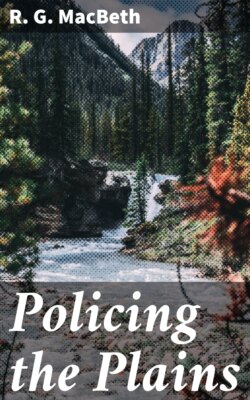Читать книгу Policing the Plains - R. G. MacBeth - Страница 12
На сайте Литреса книга снята с продажи.
THE AMAZING MARCH
ОглавлениеTable of Contents
That thunderstorm, with the resultant stampede at Dufferin, along with some blood-curdling prophecies of attacks by the scalp-gathering Sioux Indians, had the good effect of weeding out the few non-adventurous spirits who, up to now, had thought that the hardships and dangers of the expedition had been painted in too lurid a colour. This suited Colonel French, as he had no desire to venture into the wilderness with any but the very best of men. A very necessary part of Police equipment, namely their revolvers, did not arrive from England till early in July, but once they had come French, who was impatient of delay in beginning so tremendous a trek, gave orders on July 8 for a "pull out," or what the old traders used to call "a Hudson's Bay start." The idea of a "pull out" before the real journey began was to shake the line of the caravan into shape, take out any kinks that might need straightening, and generally see that everything was working satisfactorily. With field guns and mortars, seventy-three wagons, and 114 of the wooden prairie conveyances, known as Red River carts, new harness and other equipment that needed testing, the "pull out" in this case was highly desirable, but every care had been taken, and after a 2-mile test, camp was pitched for a day or so till the real trip, across the 1,000-mile plain, was commenced on July 10, 1874, a red-letter day in Western history.
The prairie had witnessed many a remarkable outfit striking out over the plains with dog-trains in winter and carts and buffalo-runners in summer, but it had never seen anything so business-like and highly picturesque as this Police marching-out state. The six divisions or troops of the mounted men, with the convenient alphabetical designation from "A" to "F," had been given horses of distinctive colour, so that in order there came for the start, dark bays, dark browns, light chestnuts with the guns, greys, blacks and light bays. After these came wagons, carts, cows and calves, beef cattle, and a general assortment of farming implements. Meat would be necessary when the buffalo were not available, and it would keep better "on the hoof." Posts would have to be supplied with food, and haying, ploughing and reaping would be necessary if men and horses were to live at some of the remote points. So they took the necessaries along as far as they could. Of course, the impressive order of march at the beginning could not be maintained throughout the gruelling expedition. A thousand miles across swamp and coulées and rivers, over areas of waste and desolate prairie, where fires had swept every vestige of grass away, through sections where flies and drought and excessive heat, turning into cold as the autumn approached, played the inevitable havoc. All these elements combined to throw that ordered line into confusion at times. Here and there cattle died, oxen gave out and quit, horses broke down through lack of food and water, men, hardy as they were, took ill sometimes, but none succumbed, and as Colonel French observed in concluding his first report to Ottawa: "The broad fact is apparent that a Canadian force, hastily raised, armed and equipped, and not under martial law, in a few months marched vast distances through a country for the most part as unknown as it proved bare of pasture and scanty in the supply of water. Of such a march, under such adverse circumstances, all true Canadians may well be proud." And so say we all.
